Understanding APIs-2.pptx this is a report of api
Download as PPTX, PDF0 likes13 views
Understanding APIs-2.pptx
1 of 11
Download to read offline
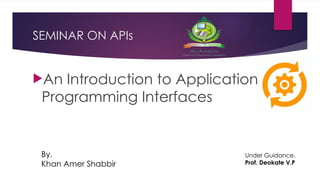
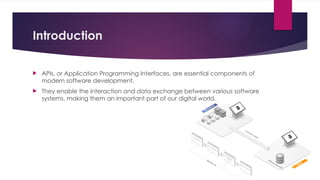
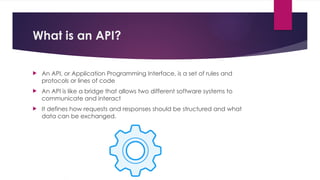

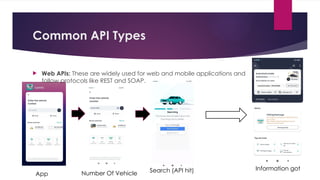



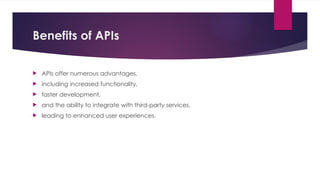


Recommended
API Testing Interview Questions PDF By ScholarHat



API Testing Interview Questions PDF By ScholarHatScholarhat
╠²
API Testing Interview Questions PDF By ScholarHatOpen api in enterprise



Open api in enterpriseGuru Lakshmeekar B
╠²
This document discusses API management. It provides an overview and describes key components like the API gateway, API manager, analytics, and developer portal. It outlines the API lifecycle and roles like the API owner, developer, admin, and consumer. The goals of API management are to securely expose information assets, inspire innovation, and increase revenue. It enables faster relationships through access control and security while exposing APIs.How To Get Started With API Testing In Your Organization.pdf



How To Get Started With API Testing In Your Organization.pdfpcloudy2
╠²
Looking into API testing is a strategic move for any organization looking to improve the reliability and functionality of its applications. What is an API Development- Definition, Types, Specifications, Documentation.pdf



What is an API Development- Definition, Types, Specifications, Documentation.pdfConnect Infosoft Technologies Pvt. Ltd.
╠²
API Development involves designing, building, and implementing Application Programming Interfaces (APIs) that enable seamless communication and data exchange between different software systems. There are various types of APIs, including RESTful APIs, SOAP APIs, GraphQL, and WebSocket APIs, each serving specific purposes. API specifications, such as OpenAPI Specification (OAS) and GraphQL Schema Definition Language (SDL), define the structure and behavior of APIs. Documentation plays a crucial role in API development, providing clear instructions, examples, and troubleshooting guidance for developers who want to integrate with the API.
Click Here For More Details: https://www.connectinfosoft.com/rest-api-development-service/Mastering API Development: A DeveloperŌĆÖs Roadmap for Success



Mastering API Development: A DeveloperŌĆÖs Roadmap for Successjayshridalwi
╠²
In todayŌĆÖs fast-paced digital landscape, API Development plays a crucial role in
building seamless and efficient software applications. Whether you're creating an
internal API for your organization or a public API for third-party integrations, having a
well-structured development approach is essential.Top 20 API Testing Interview Questions.pdf



Top 20 API Testing Interview Questions.pdfAnanthReddy38
╠²
MagnitiaŌĆÖs Web services Testing Training will provide you complete knowledge on Web services, API and their functionality. This API Testing course enables you to develop robust automation Framework for APIŌĆÖs test cases and how to test Web services and REST API using SoapUI& Rest Assured.API Notes for Recruiter.pptx



API Notes for Recruiter.pptxRaviKumar660487
╠²
API stands for application programming interface, which is a set of definitions and protocols for building and integrating application software. APIs allow applications to communicate with each other, enabling data and functionality to be shared. There are different types of API architectures including REST, SOAP, and GraphQL. API management platforms provide tools to publish, monitor, and secure APIs from various sources.Guide To API Development ŌĆō Cost, Importance, Types, Tools, Terminology, and B...



Guide To API Development ŌĆō Cost, Importance, Types, Tools, Terminology, and B...Techugo
╠²
Building an API is the foundation for any apps dealing with data or requiring communication between two goods or services. A collection of guidelines or standards known as an API allows the software to use the capabilities of another app. For example, when you choose ŌĆ£Connect with Facebook,ŌĆØ Candy Crush immediately gets your Facebook account information. It can access the Facebook server using API integration, saving you the trouble of manually entering your information.How to Develop APIs - Importance, Types, Tools, Terminology, and Best Practic...



How to Develop APIs - Importance, Types, Tools, Terminology, and Best Practic...Techugo Inc
╠²
Wondering how to develop APIs? And want to perform API integration for your business? Then you must know everything about API development. Also, get top-notch API solutions from the best API app development company. So, contact us to build an API for your business application right now! Visit: https://www.techugo.com/blog/how-to-develop-apis-importance-types-tools-terminology-and-best-practices/ Microservices&ap imanagement



Microservices&ap imanagementpramodkumards
╠²
The document discusses microservices and API management. It defines microservices as small, independent processes communicating via APIs to compose complex applications. Benefits include improved modularity, scalability, and fault isolation. API management provides tools to publish, secure, monitor, and analyze APIs. It allows enterprises to expose APIs internally or externally in a controlled manner. The document outlines considerations around microservices and features of API management systems.Introduction to API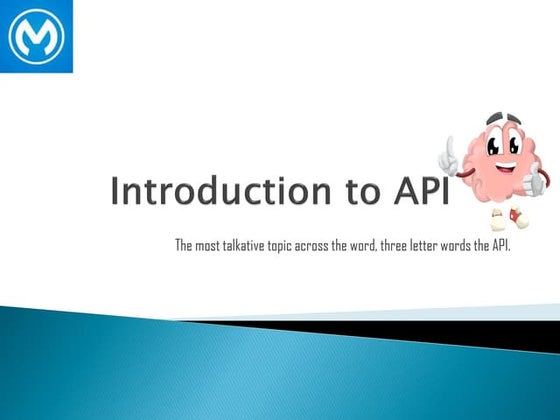



Introduction to APIrajnishjha29
╠²
The document discusses APIs, defining them as interfaces that allow applications to communicate and share data over a network. It notes that APIs act as an interface between clients and servers, exposing backend data through operations, inputs, outputs, and data types. The document also outlines the benefits of APIs in standardizing communication and enabling reusability. It introduces common API terminology and types, focusing on web APIs which are the most widely used.Guide To API Development.pdf



Guide To API Development.pdfTechugo
╠²
API (Application Programming Interface) development has become an essential aspect of modern software development. It allows different applications to interact with each other, exchange data and provide services seamlessly. To develop a successful API, you need to follow some crucial steps like defining API requirements, choosing the right protocol, designing the API interface, and testing it thoroughly. Furthermore, you should consider the security aspects of API development, including authentication, authorization, and encryption. Finally, you should document your API comprehensively, providing clear instructions for developers to use and integrate it with their applications.Api Testing.pdf



Api Testing.pdfJitendraYadav351971
╠²
API stands for Application Programming Interface and allows communication between different software applications or services. It acts as a messenger that takes orders from clients and returns responses. API testing is important as it validates APIs and their integration with services, and missed cases in API testing can cause major problems in production. Common HTTP methods used in APIs include GET, POST, PUT, PATCH, DELETE, and OPTIONS. Tools like Postman can be used to test APIs by sending requests and validating responses.The Role of APIs in Custom Software Development for 2024



The Role of APIs in Custom Software Development for 2024BOSC Tech Labs
╠²
Custom software application development services are constantly evolving, driven by the steady progress of technology.Best practices and advantages of REST APIs



Best practices and advantages of REST APIsAparna Sharma
╠²
In this article, I am going to share the best practices and the advantages of REST APIs, as I am working with a team on a REST-based web application. Newsdata.io news API is a REST-based API that fetches news data from thousands of news websites in JSON format. Therefore, I have a basic understanding of REST APIs that I am going to share with you.
What is API Development _ A Cutting-Edge API Development Unveils Seamless In...



What is API Development _ A Cutting-Edge API Development Unveils Seamless In...Grintech Web Agency
╠²
API stands for Application Programming Interface. In the context of APIs, the word Application refers to any software with a distinct function. API development refers to the process of creating Application Programming Interfaces (APIs), which are sets of rules and protocols that allow different software applications to communicate with each other.
APIs define the methods and data formats that applications can use to request and exchange information. They enable developers to build software that can interact with other systems, access external data or services, and integrate with various platforms. API development involves designing, building, testing, documenting, and maintaining APIs to ensure smooth and efficient communication between different software components or systems.
Click here : https://grintechwebagency.com/Modern APIs: The Non-Technical UserŌĆÖs Guide | The Enterprise World



Modern APIs: The Non-Technical UserŌĆÖs Guide | The Enterprise WorldEnterprise world
╠²
A Modern APIs (Application Programming Interface) is a software interface that allows two applications to communicate with each other. APIs have been around for quite a while. More Coverage, Better Diagnostics



More Coverage, Better DiagnosticsSmartBear
╠²
Ole Lensmar, co-creator of soapUI and Chief Architect at SmartBear Software, gave this presentation at STARWEST 2012. We are working, he says, in the "Golden Age of APIs." Top 11 API testing tools for 2022



Top 11 API testing tools for 2022Aparna Sharma
╠²
API testing has established a trend for automated testing as software development teams become more technologically oriented. More tools will be developed to meet these requirements. Regardless of how difficult it is to find a tool that can do everything, adopting a toolset that meets a companyŌĆÖs needs while increasing revenue is critical. Before choosing one, consider how each API testing tool may be better suited for specific purposes and what features are essential for your software development workflows.Third party api integration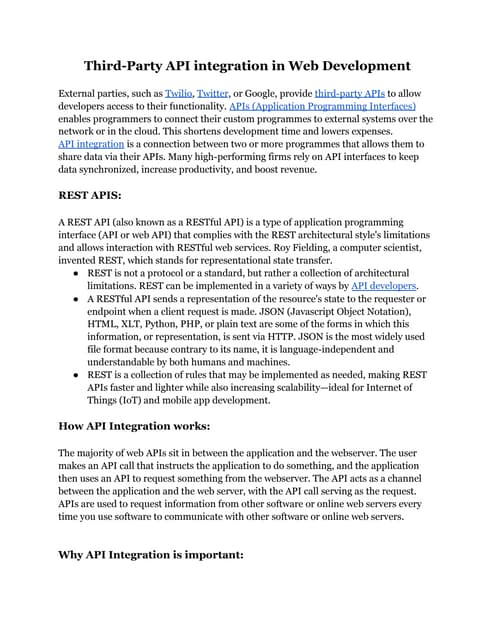



Third party api integrationMetricoid Technology
╠²
Third-party API integration.
API - application programming interfaces.
web development.
custom web development.
software development.
custom software development.
offshore software development.
API.Transform Your Operations with Cutting-Edge API Development Services.pdf



Transform Your Operations with Cutting-Edge API Development Services.pdfSeasiaInfotech2
╠²
As industry veterans, we do realize how API development is an intricate process that requires due diligence and effort.╠²API development is the process of creating an application programming interface that lets different╠²software applications╠²communicate and exchange data with each other.╠²What is Apigee.pdf



What is Apigee.pdfVishnuGone
╠²
Apigee is an API development and management platform which offers an overlay or interface for your core service APIs by presenting them with a proxy layer. This enables security, rate limitation, quotas, and analytics, among other features.
Apigee is the main source of API capabilities and procedures for producers at the moment. Programming Interface Management describes the processes and tools that enable an organization to operate and administer its APIs. It controls how the entrance is routed to the backend management and how the response is returned.Basic of API



Basic of APIRishanKP1
╠²
This document provides an overview of APIs, including what an API is, common types of APIs, HTTP request methods, and HTTP response codes. An API is a computing interface that defines interactions between software by specifying calls, data formats, and conventions. Common API types are REST, SOAP, and ASP.NET. REST is the most commonly used and user-friendly approach. HTTP methods like GET, POST, PUT, and DELETE map to CRUD operations. HTTP response codes indicate success, errors, or redirections.Apitesting.pptx



Apitesting.pptxNamanVerma88
╠²
API stands for Application Programming Interface. APIs allow communication between applications or services by providing a set of functions and procedures. API testing involves testing APIs and their integration with services to ensure correct functionality, reliability, performance, and security. Postman is a popular tool for API development that allows users to design, build, test, and document APIs through a graphical user interface.Scalling Rails: The Journey to 200M Notifications



Scalling Rails: The Journey to 200M NotificationsGustavo Araujo
╠²
Talk presented at Tropical On Rails.More Related Content
Similar to Understanding APIs-2.pptx this is a report of api (20)
How to Develop APIs - Importance, Types, Tools, Terminology, and Best Practic...



How to Develop APIs - Importance, Types, Tools, Terminology, and Best Practic...Techugo Inc
╠²
Wondering how to develop APIs? And want to perform API integration for your business? Then you must know everything about API development. Also, get top-notch API solutions from the best API app development company. So, contact us to build an API for your business application right now! Visit: https://www.techugo.com/blog/how-to-develop-apis-importance-types-tools-terminology-and-best-practices/ Microservices&ap imanagement



Microservices&ap imanagementpramodkumards
╠²
The document discusses microservices and API management. It defines microservices as small, independent processes communicating via APIs to compose complex applications. Benefits include improved modularity, scalability, and fault isolation. API management provides tools to publish, secure, monitor, and analyze APIs. It allows enterprises to expose APIs internally or externally in a controlled manner. The document outlines considerations around microservices and features of API management systems.Introduction to API



Introduction to APIrajnishjha29
╠²
The document discusses APIs, defining them as interfaces that allow applications to communicate and share data over a network. It notes that APIs act as an interface between clients and servers, exposing backend data through operations, inputs, outputs, and data types. The document also outlines the benefits of APIs in standardizing communication and enabling reusability. It introduces common API terminology and types, focusing on web APIs which are the most widely used.Guide To API Development.pdf



Guide To API Development.pdfTechugo
╠²
API (Application Programming Interface) development has become an essential aspect of modern software development. It allows different applications to interact with each other, exchange data and provide services seamlessly. To develop a successful API, you need to follow some crucial steps like defining API requirements, choosing the right protocol, designing the API interface, and testing it thoroughly. Furthermore, you should consider the security aspects of API development, including authentication, authorization, and encryption. Finally, you should document your API comprehensively, providing clear instructions for developers to use and integrate it with their applications.Api Testing.pdf



Api Testing.pdfJitendraYadav351971
╠²
API stands for Application Programming Interface and allows communication between different software applications or services. It acts as a messenger that takes orders from clients and returns responses. API testing is important as it validates APIs and their integration with services, and missed cases in API testing can cause major problems in production. Common HTTP methods used in APIs include GET, POST, PUT, PATCH, DELETE, and OPTIONS. Tools like Postman can be used to test APIs by sending requests and validating responses.The Role of APIs in Custom Software Development for 2024



The Role of APIs in Custom Software Development for 2024BOSC Tech Labs
╠²
Custom software application development services are constantly evolving, driven by the steady progress of technology.Best practices and advantages of REST APIs



Best practices and advantages of REST APIsAparna Sharma
╠²
In this article, I am going to share the best practices and the advantages of REST APIs, as I am working with a team on a REST-based web application. Newsdata.io news API is a REST-based API that fetches news data from thousands of news websites in JSON format. Therefore, I have a basic understanding of REST APIs that I am going to share with you.
What is API Development _ A Cutting-Edge API Development Unveils Seamless In...



What is API Development _ A Cutting-Edge API Development Unveils Seamless In...Grintech Web Agency
╠²
API stands for Application Programming Interface. In the context of APIs, the word Application refers to any software with a distinct function. API development refers to the process of creating Application Programming Interfaces (APIs), which are sets of rules and protocols that allow different software applications to communicate with each other.
APIs define the methods and data formats that applications can use to request and exchange information. They enable developers to build software that can interact with other systems, access external data or services, and integrate with various platforms. API development involves designing, building, testing, documenting, and maintaining APIs to ensure smooth and efficient communication between different software components or systems.
Click here : https://grintechwebagency.com/Modern APIs: The Non-Technical UserŌĆÖs Guide | The Enterprise World



Modern APIs: The Non-Technical UserŌĆÖs Guide | The Enterprise WorldEnterprise world
╠²
A Modern APIs (Application Programming Interface) is a software interface that allows two applications to communicate with each other. APIs have been around for quite a while. More Coverage, Better Diagnostics



More Coverage, Better DiagnosticsSmartBear
╠²
Ole Lensmar, co-creator of soapUI and Chief Architect at SmartBear Software, gave this presentation at STARWEST 2012. We are working, he says, in the "Golden Age of APIs." Top 11 API testing tools for 2022



Top 11 API testing tools for 2022Aparna Sharma
╠²
API testing has established a trend for automated testing as software development teams become more technologically oriented. More tools will be developed to meet these requirements. Regardless of how difficult it is to find a tool that can do everything, adopting a toolset that meets a companyŌĆÖs needs while increasing revenue is critical. Before choosing one, consider how each API testing tool may be better suited for specific purposes and what features are essential for your software development workflows.Third party api integration



Third party api integrationMetricoid Technology
╠²
Third-party API integration.
API - application programming interfaces.
web development.
custom web development.
software development.
custom software development.
offshore software development.
API.Transform Your Operations with Cutting-Edge API Development Services.pdf



Transform Your Operations with Cutting-Edge API Development Services.pdfSeasiaInfotech2
╠²
As industry veterans, we do realize how API development is an intricate process that requires due diligence and effort.╠²API development is the process of creating an application programming interface that lets different╠²software applications╠²communicate and exchange data with each other.╠²What is Apigee.pdf



What is Apigee.pdfVishnuGone
╠²
Apigee is an API development and management platform which offers an overlay or interface for your core service APIs by presenting them with a proxy layer. This enables security, rate limitation, quotas, and analytics, among other features.
Apigee is the main source of API capabilities and procedures for producers at the moment. Programming Interface Management describes the processes and tools that enable an organization to operate and administer its APIs. It controls how the entrance is routed to the backend management and how the response is returned.Basic of API



Basic of APIRishanKP1
╠²
This document provides an overview of APIs, including what an API is, common types of APIs, HTTP request methods, and HTTP response codes. An API is a computing interface that defines interactions between software by specifying calls, data formats, and conventions. Common API types are REST, SOAP, and ASP.NET. REST is the most commonly used and user-friendly approach. HTTP methods like GET, POST, PUT, and DELETE map to CRUD operations. HTTP response codes indicate success, errors, or redirections.Apitesting.pptx



Apitesting.pptxNamanVerma88
╠²
API stands for Application Programming Interface. APIs allow communication between applications or services by providing a set of functions and procedures. API testing involves testing APIs and their integration with services to ensure correct functionality, reliability, performance, and security. Postman is a popular tool for API development that allows users to design, build, test, and document APIs through a graphical user interface.What is API Development _ A Cutting-Edge API Development Unveils Seamless In...



What is API Development _ A Cutting-Edge API Development Unveils Seamless In...Grintech Web Agency
╠²
Recently uploaded (20)
Scalling Rails: The Journey to 200M Notifications



Scalling Rails: The Journey to 200M NotificationsGustavo Araujo
╠²
Talk presented at Tropical On Rails.UHV UNIT-5 IMPLICATIONS OF THE ABOVE HOLISTIC UNDERSTANDING OF HARMONY ON ...



UHV UNIT-5 IMPLICATIONS OF THE ABOVE HOLISTIC UNDERSTANDING OF HARMONY ON ...ariomthermal2031
╠²
IMPLICATIONS OF THE ABOVE HOLISTIC UNDERSTANDING OF HARMONY ON PROFESSIONAL ETHICS Mastering Secure Login Mechanisms for React Apps.pdf



Mastering Secure Login Mechanisms for React Apps.pdfBrion Mario
╠²
How to securely add login to any React application.Machine Elements in Mechanical Design.pdf



Machine Elements in Mechanical Design.pdfSLatorreAndrs
╠²
Elementos importantes para el dise├▒o de elementos mec├ĪnicosHackathon-Problem-Statements-Technology-Track-with-Link.pptx



Hackathon-Problem-Statements-Technology-Track-with-Link.pptxdatahiverecruitment
╠²
Hackathon-Problem-Statements-Technology-Track-with-Link.pptxDistillation Types & It's Applications 1-Mar-2025.pptx



Distillation Types & It's Applications 1-Mar-2025.pptxmrcr123
╠²
Distillation is a widely used method for separating mixtures╠²based on differences in the conditions required to change the╠²phase of components of the mixture.
To separate a mixture of liquids, the liquid can be heated to force components, which have different boiling points, into the gas phase. The gas is then condensed back into liquid form and collected.
Distillation can be considered as a physical separation process not a chemical reaction.
Distillation involves selective evaporation and subsequent condensation of a component in a liquid mixture.
It is a separation technique that can be used to either increase the concentration of a particular component in the mixture or to obtain (almost) pure components from the mixture.
Under a given pressure, the temperature at which a pure liquid distills (or boils) is known as ŌĆ£ Boiling Point ŌĆ£.
Technically, the boiling point of a liquid is the temperature at which the vapor pressure of a liquid equals to the surrounding atmospheric pressure, allowing bubbles of vapor to form and rise through the liquid.╠²
Distillation allows one of the liquid mixture's components into a gaseous state, taking advantage of the difference in their boiling points.
LA11-Case study of motherboard and internal components of motheroard.docx



LA11-Case study of motherboard and internal components of motheroard.docxVidyaAshokNemade
╠²
Thisis case study of motherboardArtificial intelligence and Machine learning in remote sensing and GIS



Artificial intelligence and Machine learning in remote sensing and GISamirthamm2083
╠²
Artificial intelligence and Machine learning in remote sensing and GIS he Wright brothers, Orville and Wilbur, invented and flew the first successfu...



he Wright brothers, Orville and Wilbur, invented and flew the first successfu...HardeepZinta2
╠²
The Wright brothers, Orville and Wilbur, invented and flew the first successful airplane in 1903. Their flight took place in Kitty Hawk, North Carolina. Industry 4.0: Transforming Modern Manufacturing and Beyond



Industry 4.0: Transforming Modern Manufacturing and BeyondGtxDriver
╠²
This document explores the fundamental concepts, technologies, and applications of Industry 4.0. Topics include automation, IoT (Internet of Things), smart factories, cyber-physical systems, and the integration of AI and big data analytics in industrial processes. It serves as a comprehensive resource for students, professionals, and enthusiasts eager to delve into the fourth industrial revolution.22PCOAM16 ML UNIT 2 NOTES & QB QUESTION WITH ANSWERS



22PCOAM16 ML UNIT 2 NOTES & QB QUESTION WITH ANSWERSGuru Nanak Technical Institutions
╠²
22PCOAM16 ML UNIT 2 NOTES & QB QUESTION WITH ANSWERS Airport Components Part1 ppt.pptx-Site layout,RUNWAY,TAXIWAY,TAXILANE



Airport Components Part1 ppt.pptx-Site layout,RUNWAY,TAXIWAY,TAXILANEPriyanka Dange
╠²
RUNWAY,TAXIWAY,TAXILANEOptimize AI Latency & Response Time with LLumo



Optimize AI Latency & Response Time with LLumosgupta86
╠²
Long response times kill user experience. We provide real-time monitoring and optimizations to ensure fast, seamless interactions.NFPA 70B & 70E Changes and Additions Webinar Presented By Fluke



NFPA 70B & 70E Changes and Additions Webinar Presented By FlukeTranscat
╠²
Join us for this webinar about NFPA 70B & 70E changes and additions. NFPA 70B and NFPA 70E are both essential standards from the National Fire Protection Association (NFPA) that focus on electrical safety in the workplace. Both standards are critical for protecting workers, reducing the risk of electrical accidents, and ensuring compliance with safety regulations in industrial and commercial environments.
Fluke Sales Applications Manager Curt Geeting is presenting on this engaging topic:
Curt has worked for Fluke for 24 years. He currently is the Senior Sales Engineer in the NYC & Philadelphia Metro Markets. In total, Curt has worked 40 years in the industry consisting of 14 years in Test Equipment Distribution, 4+ years in Mfg. Representation, NAED Accreditation, Level 1 Thermographer, Level 1 Vibration Specialist, and Power Quality SME.Self-Compacting Concrete: Composition, Properties, and Applications in Modern...



Self-Compacting Concrete: Composition, Properties, and Applications in Modern...NIT SILCHAR
╠²
Self-Compacting Concrete (SCC) is a high-performance material that flows under its own weight, eliminating the need for vibration. It offers superior workability, durability, and structural efficiency, making it ideal for complex designs, congested reinforcement, and sustainable construction practices."Introduction to VLSI Design: Concepts and Applications"



"Introduction to VLSI Design: Concepts and Applications"GtxDriver
╠²
This document offers a detailed exploration of VLSI (Very Large-Scale Integration) design principles, techniques, and applications. Topics include transistor-level design, digital circuit integration, and optimization strategies for modern electronics. Ideal for students, researchers, and professionals seeking a comprehensive guide to VLSI technology.Understanding APIs-2.pptx this is a report of api
- 1. SEMINAR ON APIs ’üĄAn Introduction to Application Programming Interfaces By. Khan Amer Shabbir Under Guidance. Prof. Deokate V.P
- 2. Introduction ’üĄ APIs, or Application Programming Interfaces, are essential components of modern software development. ’üĄ They enable the interaction and data exchange between various software systems, making them an important part of our digital world.
- 3. What is an API? ’üĄ An API, or Application Programming Interface, is a set of rules and protocols or lines of code ’üĄ An API is like a bridge that allows two different software systems to communicate and interact ’üĄ It defines how requests and responses should be structured and what data can be exchanged.
- 4. How APIs Work ’üĄ APIs work by providing a way the method (GET, POST, etc.) and any required parameters. ’üĄ This can be done through HTTP requests, function calls, or other communication methods, depending on the API type. ’üĄ The API server processes the request and performs the necessary actions ’üĄ The response is sent back to the client in the specified data format (e.g., JSON or XML). ’üĄ The client receives the response, and takes action based on the information got from the API.
- 5. Common API Types ’üĄ Web APIs: These are widely used for web and mobile applications and follow protocols like REST and SOAP. App Number Of Vehicle Search (API hit) Information got
- 6. Common API Types ’üĄ Library APIs: These provide predefined functions and command for specific programming languages. ’üĄ provide a set of functions, or classes that allow developers to access and use specific functionalities or resources within a particular programming language or framework. 1 Python: NumPy, Pandas, Django/Flask 2 Java Standard Libraries: java.awt and javax.swing, JUnit 3 JavaScript: React, Vue.js, Moment.js
- 7. Common API Types ’üĄ Hardware APIs: These enable software to interact with hardware components like printers, cameras, and sensors. ’üĄ Operating System APIs: These allow applications to interact with the operating system.
- 8. API Authentication & Security ’üĄ Security is a critical aspect of APIs. Protecting data and preventing unauthorized access are essential. ’üĄ API authentication is the process of verifying the identity of a client (an application or user) that is trying to access an API ’üĄ It ensures that only authorized and authenticated entities can make requests and access the resources provided by the API. ’üĄ It prevents unauthorized access And its protects sensitive data and resources. ’üĄ Common Methods of API Authentication API keys, OAuth, and token- based authentication.
- 9. Benefits of APIs ’üĄ APIs offer numerous advantages, ’üĄ including increased functionality, ’üĄ faster development, ’üĄ and the ability to integrate with third-party services, ’üĄ leading to enhanced user experiences.
- 10. Conclusion ’üĄ APIs have revolutionized the way software interacts and are at the heart of modern application development. Understanding how to use and design APIs is key to building powerful, interconnected applications. ’üĄ Reference Chat.openai.com Google.com Wikipedia.org Javatpoint.com Stackoverflow.com







